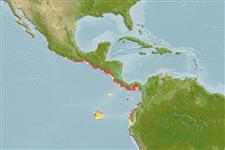>
Clupeiformes (Herrings) >
Dorosomatidae (Gizzard shads and sardinellas)
Etymology: Opisthonema: Greek, opisthe = behind + Greek,nema = filament (Ref. 45335).
More on author: Regan.
Environment: milieu / climate zone / depth range / distribution range
Ecologia
marino; distribuzione batimetrica 0 - 50 m (Ref. 188). Tropical; 25°N - 5°S, 109°W - 77°W (Ref. 188)
Eastern Pacific: Baja California, Mexico southward to Punta Sal and Punta Picos, Peru.
Size / Peso / Age
Maturity: Lm ? range ? - ? cm
Max length : 20.0 cm TL maschio/sesso non determinato; (Ref. 55763); common length : 18.0 cm SL maschio/sesso non determinato; (Ref. 188)
Short description
Chiavi di identificazione | Morfologia | Morfometria
Spine dorsali (totale) : 0; Raggi dorsali molli (totale) : 13 - 21; Spine anali: 0; Raggi anali molli: 12 - 23. The filamentous last dorsal fin rays distinguish it from any other eastern Pacific genus. Separated from other eastern Pacific Opisthonema by having only 25 to 36 lower gill rakers in fishes over 14 cm standard length.
Forms schools. Apparently the least abundant of the eastern Pacific species of Opisthonema. Feeds on crustaceans and pteropods. Caught along with the other species of the genera.
Life cycle and mating behavior
Maturities | Riproduzione | Spawnings | Egg(s) | Fecundities | Larve
Whitehead, P.J.P., 1985. FAO Species Catalogue. Vol. 7. Clupeoid fishes of the world (suborder Clupeoidei). An annotated and illustrated catalogue of the herrings, sardines, pilchards, sprats, shads, anchovies and wolf-herrings. FAO Fish. Synop. 125(7/1):1-303. Rome: FAO. (Ref. 188)
IUCN Red List Status (Ref. 130435)
Threat to humans
Harmless
Human uses
Pesca: pesca di sussistenza
Strumenti
Special reports
Download XML
Fonti Internet
Estimates based on models
Preferred temperature (Ref.
123201): 24.6 - 28.6, mean 27 °C (based on 34 cells).
Phylogenetic diversity index (Ref.
82804): PD
50 = 0.5312 [Uniqueness, from 0.5 = low to 2.0 = high].
Bayesian length-weight: a=0.00912 (0.00433 - 0.01920), b=3.04 (2.87 - 3.21), in cm total length, based on LWR estimates for this (Sub)family-body shape (Ref.
93245).
Trophic level (Ref.
69278): 3.2 ±0.38 se; based on food items.
Resilienza (Ref.
120179): Alto, tempo minimo di raddoppiamento della popolazione meno di 15 mesi (Preliminary K or Fecundity.).
Fishing Vulnerability (Ref.
59153): Low vulnerability (10 of 100).
